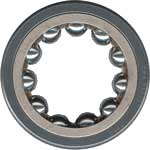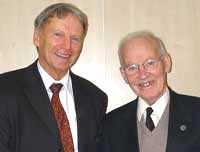World leaders in ring-rolling visit IfM
|
|
The IfM recently welcomed three of the world's leading experts on ring-rolling as part of an ongoing collaboration to develop more flexible ring-rolling machines. Ring-rolling is a process used to make seamless metal rings that form the basis of bearings, railway wheels, gears and many components in gas turbines. The visitors were Professor Kopp, director of the Institute fur Bildsame Formgebung at RWTH-University in Aachen, Professor Tekkaya from Middle Eastern Technical University, and Professor William Johnson - now retired, but previously professor of mechanical engineering at UMIST and Cambridge. Professors Kopp and Johnson are the two dominant figures in this area, and had not met prior to the meeting in Cambridge.
Incremental sheet forming
The visit included a demonstration of a test-rig for the incremental sheet forming process. Incremental sheet forming is an alternative to metal pressing or stamping. Pressing requires specialist tooling for each product, which is expensive and difficult to design, which in turn requires large batch volumes to offset tooling costs. In incremental sheet forming, an indentor tracks round the workpiece, incrementally developing any chosen shape. This leads to lower production rates, but no tooling costs, and potentially is an attractive solution for flexible low-volume manufacturing.
Incremental sheet forming was first explored in the Institute for Manufacturing in 1990 by Colin Andrew, and then taken up and developed in Japan during the 1990s. The new machine is the first dedicated rig built outside Japan, and a second international group comprising most of the existing research groups active in this area will be visiting the IfM on 22nd October to see it and continue an existing collaboration.
Most studies in incremental sheet forming to date have been with one indentor only, and based around modifications to existing CNC tools. The IfM is developing a specialist rig which will eventually have two indentors to explore the technical and commercial potential of this process.











